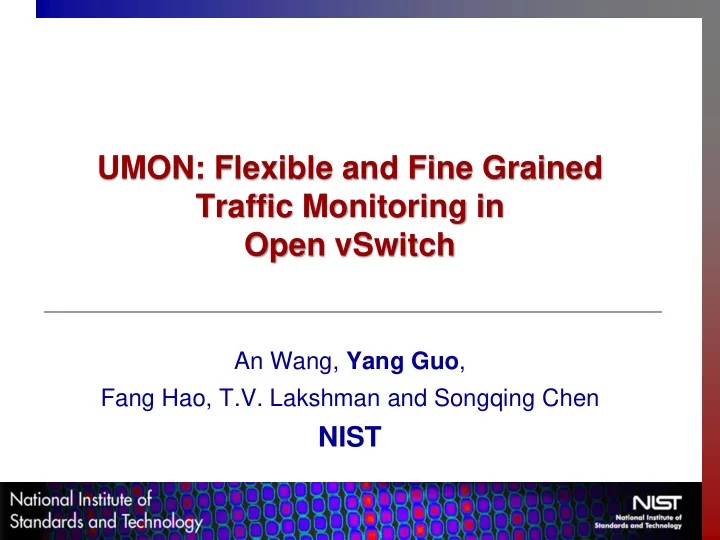

UMON: Flexible and Fine Grained Traffic Monitoring in Open vSwitch An Wang, Yang Guo , Fang Hao, T.V. Lakshman and Songqing Chen NIST
Outline Introduction UMON design and implementation Evaluation Summary Credit: – An Wang, Songqing Chen from GMU – Fang Hao, T.V. Lakshman from Bell Labs 2
Introduction Fine-grained network traffic monitoring is important for effective network management – Traffic engineering, anomaly detection, network diagnosis, traffic matrix estimation, DDoS detection and mitigation, etc. Scalability has been the main challenge – High switching speed – Large number of flows – Solution : sampling, probabilistic based measurement, hardware enhanced measurement solutions, etc. Open vSwitch (OVS) is a popular software switch widely employed by SDN – Developed by Nicira as an edge switches for Data center SDN solution – slower switching speed, smaller #flows, access to more CPU and memory resources – Similar monitoring tools as hardware switches: Netflow, sFlow, SPAN, RSPAN, flow entry counts 3
Introduction Recent push to use flow entry counts for traffic monitoring Challenges in flow entry counts monitoring – TCAM space is limited in hardware switches – header fields of interest for packet forwarding may not overlap with those of interest for monitoring – Interaction between forwarding and monitoring is not trivial – May force SDN to work in reactive mode: constant controller involvement Our Idea: leverage software switch to provide user-defined traffic monitoring 4
Introduction Why software switch? – Slower switching speed – Access to more resources (both CPU and memory) – Sitting at the edge – Open source What UMON likes to achieve? – Monitor arbitrary fields – Sub-flow monitoring, e.g., monitor micro/sub-flows of a mega-flow, without constant controller involvement – Allow to push other management functions, such as anomaly detection, to the switches 5
UMON: Design and Implementation How to instrument the software switch to support UMON? – Decoupling monitoring from forwarding – Monitoring does not interfere with forwarding Design must integrate well with the OVS architecture – Two-tiered forwarding architecture • User-level: full blown pipelined routing • Kernel-level: flow entry caching 6
UMON: Design and Implementation User level decoupling – a separate monitoring flow table, where the monitoring rules are stored Packet Ingress Moni- Out Table Table Table toring Port Packet 0 1 n Table Execute Action Set Action Action Set Set = {} Anomaly Detection module Microflow table 7
UMON: Design and Implementation Kennel level decoupling – Kernel rule does not support priority – For a packet, at most one rule matches the header – Adding a monitoring table in kernel is ‘heavy’ – carefully designed kernel flow rules that satisfy the monitoring requirements • Kernel rule must be ‘finer’ than the monitoring rule Let 𝒔 𝒈 , 𝒏 𝒈 be the generated kernel flow rule and its mask; 𝒔 𝒋 , 𝒏 𝒋 , 𝒋 ∈ 𝑱, be the monitoring rule set in the monitoring table ∗ ≜ 𝒏 𝒈 | 𝒏 𝒈 | 𝒋∈𝑱 𝒈 𝒏 𝒋 , where 𝑱 𝒈 ≜ 𝒋 𝒔 𝒈 & 𝒏 𝒈𝒋 = 𝒔 𝒋 & 𝒏 𝒈𝒋 , 𝒋 ∈ 𝑱}, 𝒏 𝒈𝒋 ≜ 𝒏 𝒈 & 𝒏 𝒋 . 8
UMON: Design and Implementation Traffic monitoring of non-routing fields – New monitoring actions to collect stats of non-routing fields – E.g. SYN Monitoring Action , ACK Monitoring Action , etc. Sub-flow monitoring – Sub-flows are the fine-grained flows that belong to a mega-flow as defined by the monitoring rule – Sub-flow is defined by sub-flow mask 𝑡 𝑗 – generate proper kernel flow rules Monitoring rule insertion/deletion – When removing a monitoring rule => ‘lazy’ approach – When a monitoring rule is added => ‘complex’ • make sure the kernel rule’s granularity is still fine • If not, purge the rules. Proper rule will be added when next packet arrives 9
Evaluation Setting: – Open vSwitch (version 2.3) – A standalone machine with 2.67GHz CPU (12 cores), 64G memory, and an Intel NIC of two 10G ports – One server, one client – Compare performance of UMON, default OVS, and micro-flow enabled OVS 10
Evaluation UMON overhead evaluation – DECONF trace with 272 hosts and 4432 micro-flows – Monitor 150 hosts with micro-flow monitoring on – Transmit at 2.2 Gbps ‘Gap’ is due to Generic Receive Offload option (GRO) at NIC 11
Evaluation UMON overhead evaluation Handler Revalidator FlowTableSize MissPktRate OVS 0.0% 0.60% 295 0 Microflow OVS 0.15% 6.8% 4381 30 UMON 0.21% 9.9% 4301 26 CPU utilizations are low for all three types of vSwitches Revalidator threads consume much more CPU resources than the handler threads due to large flow table size and monitoring activity 12
Evaluation Effect of monitoring rules Tradeoff between #monitoring-rules, kernel flow table size, and CPU utilization is possible 13
Conclusions and Future Work UMON: decouples monitoring from forwarding, and offers flexible and fine-grained monitoring in OVS Design and implement UMON Evaluate the prototype Design and specify OpenFlow interface for UMON Distributed UMON monitoring network for DDoS detection 14
Backup slides 15
Evaluation Effect of monitoring rules 16
Recommend
More recommend